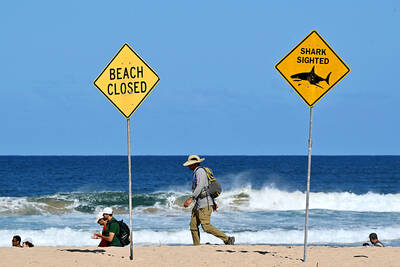The tribes of the lower Klamath River have since ancient times decorated themselves with condor feathers when they performed the dances designed to heal a world gone wrong.
“It can soar the highest, so we figured that was the one to get our prayers to heaven when we were asking for the world to be in balance,” said Richard Myers, a member of the Yurok Tribal Council and a leader in the revival of the tribe’s world renewal ceremonies.
Now the Yurok Tribe is using modern science in hopes of restoring condors, which have not soared above the northern coast of California since 1914.
If they establish that condors can survive here, and get federal permission to introduce birds from a captive breeding program, it would be the first restoration of condors in the northern half of its historic range, and a stepping stone to condors soaring over Oregon and Washington.
With a US$200,000 grant from the US Fish and Wildlife Service, the tribe is trapping turkey vultures to test for lead poisoning from eating the rotting remains of deer and elk contaminated by lead bullets, and cutting plugs of blubber from dead sea lions to measure the legacy of DDT pesticides. Those tests will help determine potential toxic threats to condors.
Researchers from Oregon State University and the Oregon Zoo are computer mapping areas throughout the Northwest where condors can nest in big trees and rocky cliffs, and soar over steep hillsides with the kind of sustained winds that draw hang gliders.
“He was like the boss of all the birds,” Myers said. “At one point in time in our world we know where the beginning of the world was. We call it Kenick. The birds and animals would all speak the same language. He was the first one. He was also the first one to go extinct for whatever reasons.”
The details of why condors went extinct in the Northwest are not clear. Tribal wildlife biologist Chris West figures that a big factor was commercial whaling and sealing, which deprived the birds of a major source of food washing up on the beach. Tests of feathers indicate marine sources comprised up to half the diet of some birds.
That’s why he drove two hours South to Ferndale, then hiked nearly an hour back up the beach to find a dead sea lion reported by another biologist.
The Yurok need to establish how safe it will be for condors to feed on whales and sea lions, because their blubber is the repository of DDT pesticides and related chemicals dumped in the ocean decades ago. Like eagles, condors in the 1960s and 1970s became unable to hatch their eggs because DDT made the shells too thin, West said.
When West found the sea lion, it was seething with maggots, too far gone for drawing samples of blood and blubber.
The state of the carcass illustrates the role condors played in the ecology of the North Coast, West said. They are the only scavengers strong enough to rip open such tough hide, allowing gulls and turkey vultures to join the feast.
In another attempt to measure lead levels, Tiana Williams sat hidden and quiet in the hills above Orick, watching the stinking remains of roadkilled deer and raccoons that would draw turkey vultures into a trap.
After graduating from Harvard in biochemistry, she came home to work for her tribe.
“They are considered a sacred animal,” Williams said of condors. “You are never ever supposed to molest them. You are never supposed to kill them. We use their feathers for ceremonies. If you get a feather, it has to be given by the bird. You have to find it on the ground.”
“Condors being the first animal we bring back to Yurok ancestral territory is a really powerful thing to me, as the first step toward renewal of our land,” she said.
After a bird struggled through a one-way wire entry into the trap, she threw a flannel sheet over it and held it gently in her lap. West inserted a needle in a leg vein, drawing blood to test for lead.
Lead poisoning is the leading cause of death for condors in the wild, said Chris Parish, condor program director for the Peregrine Fund, which breeds birds in Boise, Idaho, and releases them at the Grand Canyon.
At last count there were 180 condors in the wild in North America, up from 23 in the 1980s, said Fish and Wildlife spokesman Michael Woodbridge. Zoos and captive breeding programs have 176.

With much pomp and circumstance, Cairo is today to inaugurate the long-awaited Grand Egyptian Museum (GEM), widely presented as the crowning jewel on authorities’ efforts to overhaul the country’s vital tourism industry. With a panoramic view of the Giza pyramids plateau, the museum houses thousands of artifacts spanning more than 5,000 years of Egyptian antiquity at a whopping cost of more than US$1 billion. More than two decades in the making, the ultra-modern museum anticipates 5 million visitors annually, with never-before-seen relics on display. In the run-up to the grand opening, Egyptian media and official statements have hailed the “historic moment,” describing the

SECRETIVE SECT: Tetsuya Yamagami was said to have held a grudge against the Unification Church for bankrupting his family after his mother donated about ¥100m The gunman accused of killing former Japanese prime minister Shinzo Abe yesterday pleaded guilty, three years after the assassination in broad daylight shocked the world. The slaying forced a reckoning in a nation with little experience of gun violence, and ignited scrutiny of alleged ties between prominent conservative lawmakers and a secretive sect, the Unification Church. “Everything is true,” Tetsuya Yamagami said at a court in the western city of Nara, admitting to murdering the nation’s longest-serving leader in July 2022. The 45-year-old was led into the room by four security officials. When the judge asked him to state his name, Yamagami, who

DEADLY PREDATORS: In New South Wales, smart drumlines — anchored buoys with baited hooks — send an alert when a shark bites, allowing the sharks to be tagged High above Sydney’s beaches, drones seek one of the world’s deadliest predators, scanning for the flick of a tail, the swish of a fin or a shadow slipping through the swell. Australia’s oceans are teeming with sharks, with great whites topping the list of species that might fatally chomp a human. Undeterred, Australians flock to the sea in huge numbers — with a survey last year showing that nearly two-thirds of the population made a total of 650 million coastal visits in a single year. Many beach lovers accept the risks. When a shark killed surfer Mercury Psillakis off a northern Sydney beach last

‘CHILD PORNOGRAPHY’: The doll on Shein’s Web site measure about 80cm in height, and it was holding a teddy bear in a photo published by a daily newspaper France’s anti-fraud unit on Saturday said it had reported Asian e-commerce giant Shein (希音) for selling what it described as “sex dolls with a childlike appearance.” The French Directorate General for Competition, Consumer Affairs and Fraud Control (DGCCRF) said in a statement that the “description and categorization” of the items on Shein’s Web site “make it difficult to doubt the child pornography nature of the content.” Shortly after the statement, Shein announced that the dolls in question had been withdrawn from its platform and that it had launched an internal inquiry. On its Web site, Le Parisien daily published a